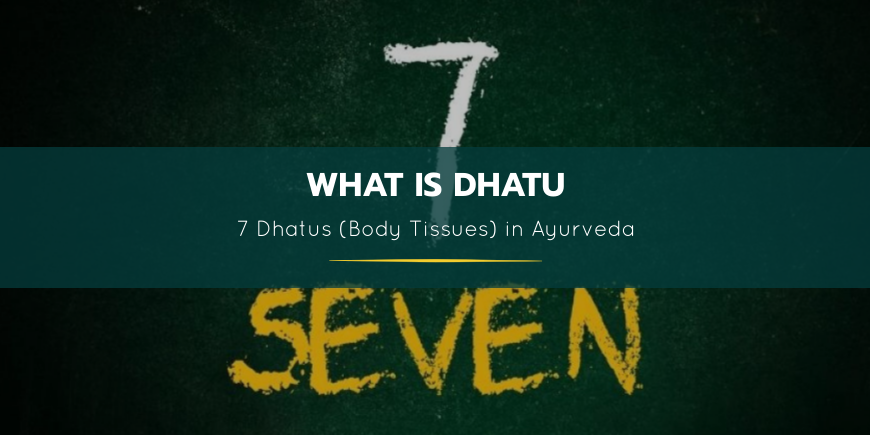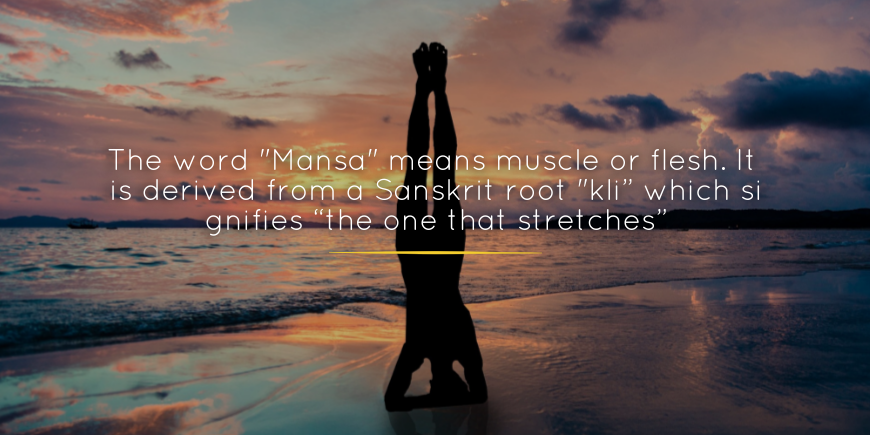
Introduction
In Ayurveda, everyone talks about dosha, the corrupting factors. However, very few people know about the sustaining factors in our body – the dhatu.
Doshas are the driving systems of the body. But what they drive are the dhatus. The word dhatu is derived from the Sanskrit word ”dharan”. Dhatu means “the one that sustains”.Dhatus are the metabolic factors that are the products of anabolism or building up processes in the body. They are stations of growth, multiplication, and functioning. The Dhatu system is comparable to the tissues system of modern medical science. It is important to note that the dhatu is not exclusively a physically present entity. Dhatu is more of a concept that is present in the entire body in different forms and proportions. Dhatu can also be called the structural units of the body.
There are 7 types of Dhatus defined in Ayurveda. They include:
Rasa
Rasa is the first dhatu that is formed after the digestion of food. Therefore, Rasa can be described as a nutritional extract that is absorbed from the intestines and circulated throughout the body for overall nourishment. Rasadhatu is the source of all the other tissues. Rasadhatu has the function of nourishing & imparting life (preeran) to each cell of the body.
Therefore Rasadhatu can be most appropriately described as the tissue fluid that oozes out of the blood vessels and spreads in the tissue, providing nourishment to different parts. Rasadhatu is a site of Kaphadosha and is cool and stable.
Rasadhatu is also the precursor of the next dhatu – Rakta
Summary
Rasadhatu forms as the end product of the digestive process i.e. essence of digested food. It is the nutritional fluid that provides vital nutrients to all body cells. Rasa transforms to rakta (blood) in the tissue upgrading process.
Rakta
RaktaDhatu is the second dhatu. It is formed from the essence of rasadhatu. RaktaDhatu is equivalent to the blood tissue in the body. The word Rakta means the one that is transformed to a red color (through the action of fire). According to Ayurvedic text (SushrutSamhita), raktavahastrotasa(channel) or the circulatory system have roots in the liver and spleen. According to modern physiology, detoxification of the blood happens in the liver. The spleen is often called the “graveyard of red blood cells.” It is the place where old RBCs are replaced with new ones.
The function of Raktadhatu is called “Jeevan”(life sustaining). The word Jeevan signifies activity induced by life. Blood is supposed to circulate “prana vayu” or oxygen in the body. Oxygen is the source of all energy and activity in the body. Rakta helps to maintain the body temperature, it patrols the body and kills the pathogens. Rakta is the site of pittadosha and is a subject of constant chemical transformation.
Raktadhatu is the precursor of the next dhatu – Mansa
Summary
Rakta (blood) forms from the transformation of rasa (digested juice/chyle) in the liver. It is the vehicle of nutritional and “prana” (oxygen) supply in all body cells.Raktadhatu is the raw material for the next higher tissue – muscles.
Mansa
The word “Mansa” means muscle or flesh. It is derived from a Sanskrit root “kli” which signifies “the one that stretches”. The primary function of Mansadhatu is “lepan” or wrapping/masking. According to the Ayurvedic definition of Mansadhatu, it is the tissue that nurtures/fills up the body, covers the internal organs, is connected to tendons (snayu), ligaments and is responsible for contraction and relaxation. Mansadhatu forms mansadhara kala or a muscular layer all over the body. Mansadhatu is responsible for all kinds of voluntary as well as involuntary activity in the body.
Mansadhatu is the site of KaphaDosha. The stability and strength of muscles are derivatives of KaphaDosha.
Mansadhatu is the precursor of the Medadhatu.

Summary
Mansa (muscular tissue) wraps the body and provides a tool for all activities, voluntary or involuntary. In the next stage, muscles tissue dissolves to form adipose tissue.
Meda
The fourth dhatu or tissue system is Medadhatu. The word meda means the one that lubricates/moistens/oils. Medadhatu is present around almost every organ and joint. The primary function of medadhatu is to lubricate. It facilitates easy movement in the internal cavity by acting as a rolling layer.
Adipose tissue also protects the internal organs from external shock or injury. The abdominal fat deposits protect the vital organs in the abdominal cavity. At the same time, the flexible fat lining helps the abdomen to expand if need be.
The fat tissue is also a storage point for many fat-soluble nutrients. According to Ayurveda, Medadhatu is the source of sweat. Therefore, it also helps in the process of peripheral excretion.
Fat tissue is crucial for heat preservation. It acts like a blanket that provides an extra layer of insulation between the skin and the internal body. The fat tissue in animals like the polar bear is crucial for their survival in the frigid cold of the north pole!
Excess increases in medadhatu can lead to obesity and low stamina. Medadhatu is the site of KaphaDosha. It is dominated by the Jala (fluid) element.
Medadhatu is the source for the next dhatu – Asthi
Summary
The fourth tissue meda (adipose tissue) provides a protective covering, effective shock absorption, fat and nutrition storage, and heat preservation. Medadhatu forms bones in the next stage of metabolism.
Asthi
According to Ayurvedic physiology, when medadhatuis baked in the metabolic fire, its moisture is extracted/dried by the Vayu element. Thus a hardened tissue called Asthi or bone tissue is formed in the body. Asthidhatu forms asthidhara kala or the bony layer/skeleton inside the body.
The primary function of Asthidhatu is “dharana” or to hold the body. Asthidhatu provides support to the body, helps in the movement and locomotion, protects the internal organs from injury (for example – the bony cage protects the lungs and heart, cranial bones protect the brain and spinal cord).
Asthidhatu is the abode of vatadosha. Therefore major disorders of asthi are related to hyper or hypoactivity, for example – dislocation, wearing out, dryness in joints, lack of lubrication, etc.
Asthidhatu is the base for the formation of the 6th dhatu – Majja
Summary
Asthi or the bony tissue provides the basic structure and support to the body. It is the basis for body movement. Asthi dissolves to give rise to the next tissue structure –majja (marrows).
Majja
Majjadhatuis described as the “Saar” or essence of the Asthidhatu in two ways. Firstly, majjadhatuis formed from the Asthidhatu, secondly, majja (bone marrow) is found in the bone cavity. The primary function of majjadhatuis defined as “purana” or to fill/pack a void/space.
Majja or bone marrow fills up space inside the marrow of big and small bones. In some Ayurvedic text, even the cerebrum that fills the cranial cavity is referred to as majjadhatu. Majja is the site of Kaphadosha and is primarily dominated by Jala (fluid) elements.
Majjadhatu is the intermediary product between asthidhatu and the final dhatu – Shukra
Summary
Majja (marrow) signifies the tissue that fills cavities in the body, including the bone marrow. For example, cerebrospinal fluid surrounds the brain. Majja evolves to form the final body tissue – Shukra or reproductive tissue.
Shukra
According to Indian Ayurveda, Shukra or sperm/eggs are formed by majjadhatu. Modern science states that sperms are formed in the scrotum. However, according to recent research, sperm cells can be created by the bone marrow. This indicates that Majja provides the appropriate raw material for the formation of sperm cells. This raw material is transported to the scrotum through blood.
The word “Shukra” is derived from the root “shuch” which means pure. Shukra or the reproductive cells (sperm/eggs) are the final dhatu of the body. It is like a student that started as a freshman (Rasa) who finally graduates as a scholar (Shukra). It is the purest or most refined of all dhatu.
Shukradhatu is present in both men and women and is responsible for reproduction. Ayurveda says that shukradhara kala or the reproductive layer is present all over the body. It means that all the processes of reproduction are governed by Shukra, whether it is the reproduction of a skin cell or a nerve cell. The sperm formed in the scrotum are only a highly concentrated part of the Shukra spread all over the body and are formed by the shukradhara kala or sperm generating layer in the scrotum.
Shukradhatu includes the sperm, semen, and other secretions participating in the reproductive process (secretions from the prostate gland, vagina, etc.). It is the origin of the subtle life force – Oja
Summary
Shukra is reproductive tissue. It is present in both men and women. In men, it forms the sperms, and in women – the ova. It is the most refined tissue that forms Ojas or the life force.
Take Away
The dosha and the dhatu are the functional basis for running the metabolism in the body. However, dhatu or the fundamental tissue provides the platform for dosha to function. Besides, dhatu are tangible structures, whereas doshas are systems that control metabolic functions. Therefore, dhatu are the foundation of life. True to their meaning, they sustain the life in the body.
The seven essential dhatu – rasa (digested juice), rakta (blood), mansa (muscle), meda (fat tissue), Asthi (bones), majja (marrows), and shukra (reproductive tissue) form in a regular sequence. The previous dhatu converts to form the higher tissue.
Are you fascinated by the ancient healing practices of Ayurveda? Our Ayurveda Certification Course is designed to immerse you in this profound tradition and empower you with the knowledge and skills to promote wellness. Enroll now and embark on a journey of self-discovery and healing.
This blog is a scratch on the iceberg called dhatu. I hope that brings a basic understanding of the dhatu structure to you.

Responses